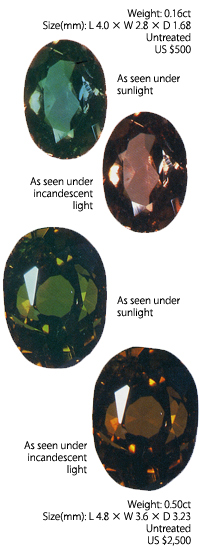CHARACTERISTICS BY COUNTRY OF ORIGIN
Alexandrite was originally discovered in 1830 in the Ural Mountain of Russia, later around the year 1900 in Sri Lanka, and then in 1987 large quantities of fine-quality material were found in Minas Gerais, Brazil. Much of the Brazilian material was brought into Japan, finding its way to many consumers during the economic boom years. However, since then the production in Brazil has floundered and alexandrite has become quite rare. Other producers include Zimbabwe, Tanzania, and Myanmar (formerly Burma).
|
 |
Russia/ Ural Region
Although these mines were said to be nearly exhausted, rough material has been finding its way to cutting centers in small quantities since the liberalization of Russia. Material from the Ural region in Russia characteristically shows a distinct color change from green to purple-red. However, most of this material contains many inclusions, and there is limited production of gem-quality material.
|
|
Brazil
Over a three-month period in 1987, a huge quantity, 50 kilograms, of alexandrite was found in the state of Minas Gerais. Until then, small quantities had been mined along with cat’s eye, but the 1987 find seems to have been extraordinary. Brazilian alexandrite has a high level of transparency, showing a strong bluish green under sunlight or fluorescent light. This changes distinctly to a purple-red under incandescent light. |
 |
Sri Lanka
In Sri Lanka also, alexandrite is mined along with cat’s eye. The material found is larger than the Russian, but it is characteristically a yellowish green, generally with a color change that is weaker than that of material from other sources. Material with a very weak change of color has little value as alexandrite. Furthermore, material that does not change color at all is simply considered chrysoberyl rather than alexandrite. |
|
 |
JUDGING QUALITY
Assuming a high level of transparency, a good appearance, and no eye-visible imperfections, gem-quality alexandrite is that which shows an attractive green under sunlight, distinctly changing to a purplish red under incandescent light. Material that does not distinctly change color is considered jewelry quality or accessory quality according to the degree of change. Most of the stones shown in the quality scale to the next page change from green to red, graded according to varying degrees of transparency, appearance, and imperfections. Even with an obvious change of color, the attractiveness of the green and red colors will greatly affect the beauty grade.
As size increase, there is a tendency for the green to become yellowish and the red to be more brown. An alexandrite of over 5 carats with a beautiful green and red color is extremely rare and valuable.
|
|